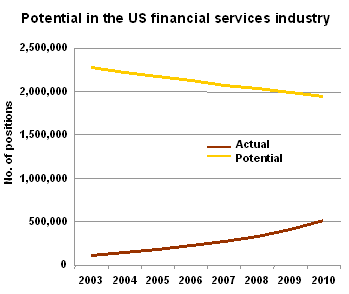| New York, NY, USA July 13, 2004 Celent finds a potential 2.3 million jobs in the banking and securities industries are currently at risk in the United States due to offshoring. Almost one third of the world痴 top financial institutions have sent work to facilities in countries other than where the work is currently taking place. These institutions are expected to significantly increase their reliance on offshoring over the next decade, and new institutions are incorporating offshoring into their business plans.  In a new report, " ," Celent examines what drives offshoring, what types of business processes are being offshored, which countries are preferred destinations, and the potential growth for the industry as a whole. It also discusses the risks faced with offshoring and how firms can prepare themselves to manage them. Finally, the report concludes with a discussion of how offshoring will evolve over the years in response to competition, automation, and consolidation. With a potential 2.3 million jobs in the banking and securities industries currently at risk in the US alone due to offshoring, the financial services industry needs to prepare a more comprehensive strategy to deal with offshoring both now and into the future. Celent estimates a potential to shift US$17.5 billion in operational and technical costs overseas by 2010, only emphasizing the urgency for financial institutions to incorporate offshoring into their service delivery models. Many of these same firms did not properly prepare for the first wave of offshoring, which typically included an outsourcing component. "Without proper due diligence, implementation planning, and ongoing vendor management, many firms found that costs were higher and quality lower than expected," says Michael Haney, a senior analyst at Celent and author of the report. In addition, public reaction has been stronger than what firms prepared for. This has resulted in new offshoring strategies, such as captive offshoring and increased outsourcing to US firms with offshoring capabilities. "In the future, automation will largely replace the need for today痴 style of offshoring, resulting in a smaller, more innovative set of offshore service providers that can truly help US financial institutions transform their businesses," states Haney. The 43-page report includes 10 tables and 17 figures. A table of contents is available online. |
of Celent Communications' Retail Banking, Wholesale Banking, Retail Securities & Investments, and Institutional Securities & Investments research services can download the report electronically by clicking on the icon to the left. Non-members should contact info@celent.com for more information. |
|





